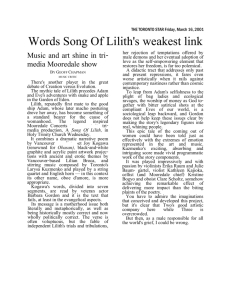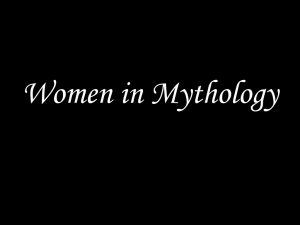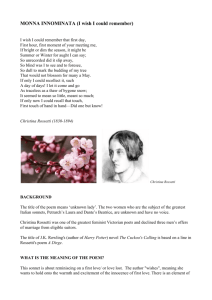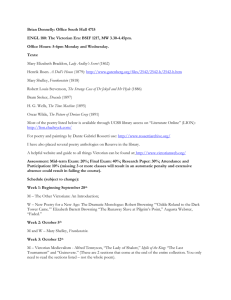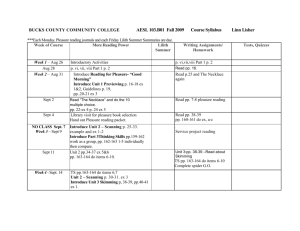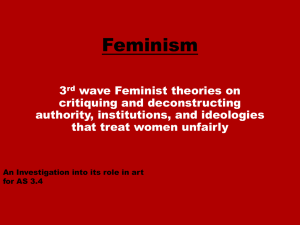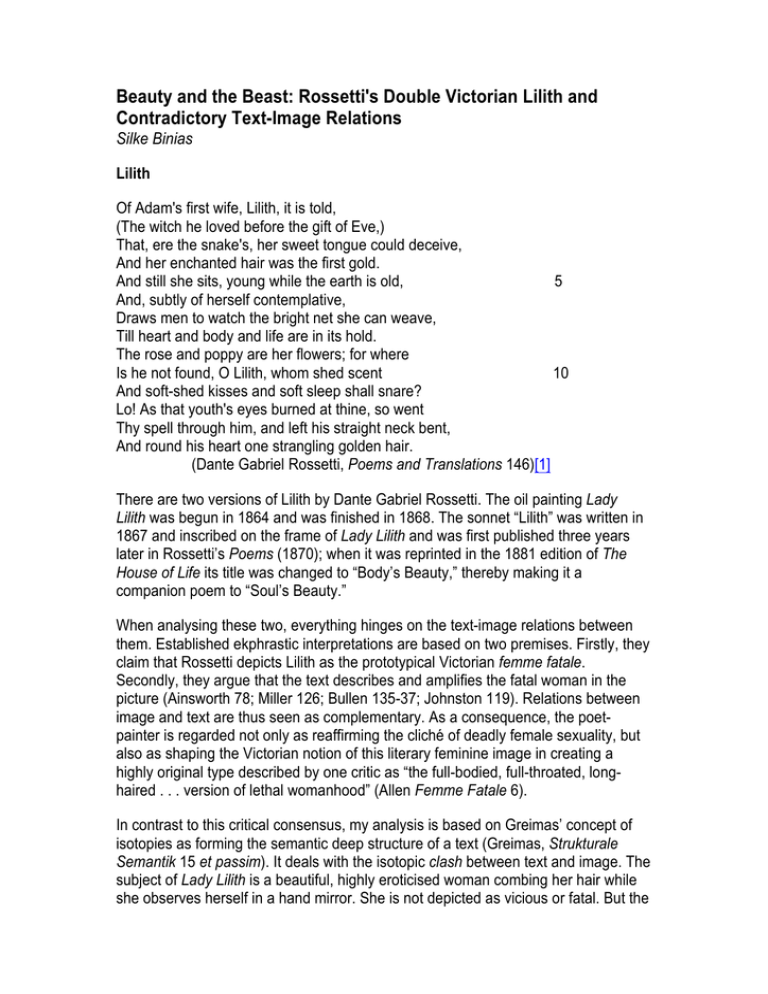
Beauty and the Beast: Rossetti's Double Victorian Lilith and
Contradictory Text-Image Relations
Silke Binias
Lilith
Of Adam's first wife, Lilith, it is told,
(The witch he loved before the gift of Eve,)
That, ere the snake's, her sweet tongue could deceive,
And her enchanted hair was the first gold.
And still she sits, young while the earth is old,
5
And, subtly of herself contemplative,
Draws men to watch the bright net she can weave,
Till heart and body and life are in its hold.
The rose and poppy are her flowers; for where
Is he not found, O Lilith, whom shed scent
10
And soft-shed kisses and soft sleep shall snare?
Lo! As that youth's eyes burned at thine, so went
Thy spell through him, and left his straight neck bent,
And round his heart one strangling golden hair.
(Dante Gabriel Rossetti, Poems and Translations 146)[1]
There are two versions of Lilith by Dante Gabriel Rossetti. The oil painting Lady
Lilith was begun in 1864 and was finished in 1868. The sonnet “Lilith” was written in
1867 and inscribed on the frame of Lady Lilith and was first published three years
later in Rossetti’s Poems (1870); when it was reprinted in the 1881 edition of The
House of Life its title was changed to “Body’s Beauty,” thereby making it a
companion poem to “Soul’s Beauty.”
When analysing these two, everything hinges on the text-image relations between
them. Established ekphrastic interpretations are based on two premises. Firstly, they
claim that Rossetti depicts Lilith as the prototypical Victorian femme fatale.
Secondly, they argue that the text describes and amplifies the fatal woman in the
picture (Ainsworth 78; Miller 126; Bullen 135-37; Johnston 119). Relations between
image and text are thus seen as complementary. As a consequence, the poetpainter is regarded not only as reaffirming the cliché of deadly female sexuality, but
also as shaping the Victorian notion of this literary feminine image in creating a
highly original type described by one critic as “the full-bodied, full-throated, longhaired . . . version of lethal womanhood” (Allen Femme Fatale 6).
In contrast to this critical consensus, my analysis is based on Greimas’ concept of
isotopies as forming the semantic deep structure of a text (Greimas, Strukturale
Semantik 15 et passim). It deals with the isotopic clash between text and image. The
subject of Lady Lilith is a beautiful, highly eroticised woman combing her hair while
she observes herself in a hand mirror. She is not depicted as vicious or fatal. But the
sonnet describes Lilith from Jewish mythology and scripture, a deceitful “witch” (2)
and a victimiser of men. The relations of text to image here are not complementary,
but contradictory. They are based on negation: the text conveys a statement that
contradicts the image. Such a view has important consequences for the conclusions
feminist critics in particular have drawn about the painting and about Rossetti.
As early as 1868, Swinburne, in his review of Lady Lilith, had drawn attention to the
inoffensive nature of the painted woman, stressing that the picture does not feature
Lilith as a witch: “Of evil desire or evil impulse she has nothing; and nothing of good.
She is indifferent, equable, magnetic; she charms and draws down the souls of men
by pure force of absorption, in no wise wilful or malignant” (212). This discrepancy
between the two Lilith representations has also been noted by a number of scholars,
who have attempted to explain away the antithetical relationship between image and
text by reading the sonnet as a set of instructions for interpreting the picture.
Catherine Golden exemplifies this approach: “the painting,” she writes, “posits in the
reader a concrete graphic knowledge which strengthens and specifies the visual
imagery of the sonnet.” Golden makes the comparison with Rossetti’s numerous
other woman-and-flower pictures: these paintings “appear at first glance as portraits
of beautiful women,” while the sonnets attached to them “reveal the symbolism
behind the feminine subjects. The sonnets give a portion of the history behind the
principle figure on canvas” (Golden 395-96. See also Allen, “Strangling Golden Hair”
291; Johnston 119).
I will argue along the following lines: first, in the literary-critical tradition of
psychologising the implied speakers of Victorian poems, I will read the poem as
the monologue intérieur of an art spectator, and as the interpretation of a man’s
interpretation of a picture. Secondly, I will try to show that the question of why this
spectator is incapable of perceiving feminine beauty for what it is, but demonises it
instead in accordance with a traditional image of fatal femininity, is essential to
Rossetti’s seemingly incongruous combination of picture and text. It is also essential
to the more general socio-psychological repercussions both forms of art draw
attention to. I will suggest that Rossetti’s double work of art explicitly displays the
construction of gender stereotypes in the motif of the fatal woman precisely because
his double Lilith is based on the different semantic and semiotic implications of the
visual and the verbal portrait of Lilith. Following Roland Barthes’ theory of myths, I
view the text as presenting culturally specific connotations of feminine beauty as
denotative meanings that demonise female sexuality (Barthes “Myth Today” 11-14).
There is a pragmatic reason for reading the poem as the interior monologue of a
spectator who is positioned in front of the canvas, exactly where we stand when
looking at the painted woman. The poem is inscribed onto the frame of the painting.
Thus, Rossetti has not only included the semiotic differences between the two
artistic media he uses: he has also assigned a semantic function to this frame. It
establishes a causal relation between his two Lilith representations. The speaker’s
words frame the painted woman as Lilith. The painting is completed by
interpretation, and, as we shall see, the text controls the understanding—or, to be
more precise, the misunderstanding—of the painting. Thus, the type of intertextuality
we are dealing with here is anagrammatical: Rossetti adopts a communicative
situation from an established poetic tradition—ekphrasis—and uses this tradition as
a foil for a later text.
In my reading, the poem’s descriptions of the painted woman and the judgements
passed on her are the mental creation of the beholder (the drama, after all, is in the
sonnet, not in the painting). His ideas are the frame limiting his view. Yet this
speaker-observer is not a voyeur spying on a lady making her toilette. When he
begins his reflections on this portrait of a woman, he is positioned in front of the
canvas, exactly where we are when looking at her:
Of Adam's first wife, Lilith, it is told,
(The witch he loved before the gift of Eve,)
That, ere the snake's, her sweet tongue could deceive,
And her enchanted hair was the first gold. (1-4)
The first line of the sonnet variation already requires particular attention: “Of Adam’s
first wife, Lilith, it is told”—the phrase “it is told” illustrates that the viewer is repeating
time-honoured knowledge, retelling an old story. So, an externally imposed idea of
female sexual allure affects his perception and superimposes itself on the image of a
loosely-dressed lady absorbed in examining herself in a hand mirror. This woman,
who in the picture does nothing more than personify physical beauty, is transformed
into the Judeo-Christian figure of Adam’s notorious first lover as we know her from
the two key Judaic intertexts, the Alphabet of Ben Sira and the Zohar, as well as
from the Apocrypha. In those sources, Lilith refuses sexual subjugation and
demands equality with Adam. She is punished by God for deserting her husband
and turns into a demoness who consumes men, thus embodying the destructive
aspects of female sexuality. The traditional Lilith propaganda is at work in Rossetti’s
sonnet and, what is most important, from the very first line its operative presence is
evident.
This propaganda and its sources are specified in the subsequent parenthetical
insertion. The woman in the painting who –it must be stressed again—does nothing
more than personify physical beauty, is immediately transformed into “Adam’s first
wife” and Eve’s precursor. What is completely disregarded by the speaker, as it
would detract from his vilification of Lilith, is that Eve did not turn out to be a “gift”
either but likewise proved to be a false promise (at least from the male point of
view).
The spectator and interpreter of body’s beauty next elaborates on the nature of and
reasons for Lilith’s crime against patriarchal rule. The sonnet’s octet is resonant with
ahistoric characterisations and with easily understandable cultural codes of
destructive femininity: the snake and spider (3, 7), animalistic images of female
sexuality; “enchanted golden hair” (4), a symbol of beauty and a means of
entrapment; eternal youth and a timeless magnetism (5), which dehumanise Lilith as
much as her self-contemplation and indifference; and the weaving of a net which
becomes a snare in her attempts at male mass murder. “[S]ubtly of herself
contemplative,” she “Draws men to watch the bright net she can weave, / Till heart
and body and life are in its hold” (6-8). Her plan of attack is very much characteristic
of a femme fatale. While attracting men who unfortunately are within the radius of
visual attention—here again is the topos of concupiscentia oculorum, the lust of the
eyes—she remains coolly aloof, “of herself contemplative,” narcissistic to the point of
complete indifference to her future clientele. Bullen perceptively remarks that her
“threat to masculinity is not so much brought about by active aggression . . . as by
passive self-absorption” (139). I shall return to this self-sufficiency and its central role
in Rossetti’s dual portrayal.
Thus established gender stereotypes evoking the fatal woman are projected onto the
painting. Those stereotypes stem from two semantic fields, from the religious (the
traditional Christian denunciation of the body) as well as the mythological (such as
the Alphabet of Ben Sira), and they direct attention to the two literary contexts in
which Lilith is present as the prototype of an alluring but treacherous she-devil. By
means of the clichés enumerated in Rossetti’s poem, the beautifulwoman in his
painting is transformed into a fatal woman who ensnares “heart and body and life”
(8).
The painting features what feminist critics have dubbed the schematised,
“fragmented body”—an analytical category which has become essential to an
investigation of the representation of women in art and literature (Cherry and Pollock
492; Pearce). That is to say, an exaggerated selection of colour-coded physical
details such as bared curves, ruby lips or luxuriant tresses, all of which are
conventionalised as connoting the wanton. The speaker’s monologue then supplies
a sequence of stereotypical allusions that cast over the physical attributes of the
woman before us the long shadow of the Christian denunciation of bodily beauty and
displays of sexuality.
The male viewer’s mental portrayal of female beauty is continued in the sestet,
where we find a final symbol of the femme fatale. We are told that “the rose and
poppy are her flowers” (9), and will probably think at once of the dialectic of passion
and poison implied by this pairing. The traditional associations of the colour red with
lust and passion are emphatically present here, as well as the poppy’s use as a
drug, an overdose of which might easily kill (opium produces a state of euphoria, but
also hallucinations, nightmares and delusions). Interestingly, however, most of the
roses in Rossetti’s painting are white. The white rose is ascribed to the Virgin Mary;
it is a heavenly flower symbolising spiritual love, innocence, virginity and purity. The
speaker-spectator of the sonnet makes no reference to the colour of the roses he
sees, thus passing over an ambiguity that might qualify his fantasy of sexual danger.
Similarly, Rossetti makes use of the polysemy of poppies to call attention to the
speaker’s one-sided interpretation. Poppy contains alkaloids which in antiquity were
used as a sedative for the sick and as an anodyne for pain; opium was likewise the
chief ingredient of laudanum, commonly used as a medicine in the nineteenth
century to induce convalescence by sleep (Zacharias 175). Therefore, the floral
imagery in the sonnet significantly adds to Lilith’s colouring as an example of
disastrous female sexuality, attractive and lethal.[2] The poem connotes an iconic
representation of feminine beauty as fatal. With the help of these connotations, the
implied speaker reinterprets a sexualised woman into a siren. He tries to turn his
connotations into denotations of fatal femininity, in a reaffirmation of symbolic
cultural codes of fatal womanhood.
We find a third semantic field in the penultimate tercet of the sonnet. Sensory
images of “scent” (9), “soft-shed kisses” and “soft sleep” (10) introduce the realm of
dreams and indicate the trance-like fascination of Lilith’s victims. Again, the
denunciatory Lilith mythology is at work in the speaker’s understanding of the
painting. This is continued in the last lines with his interpretation of the relations
between men and women as battle in which the fatal woman is victorious—and
again, none of his associations are visible in the painting. A woman’s sexuality
inevitably develops into a “net” (7), a “snare” (11), a spear-like “spell” (13) impaling
those unfortunate enough to have responded to it. In an image of female triumph,
Lilith leaves the youth’s “straight neck bent, / And round his heart one strangling
golden hair” (13-14). The contradictory text-image relations here reveal the sonnet to
be the fantasy of a speaker-spectator.
If we turn to address the crucial question of the speaker’s psychological position,
and to ask why his imagination is so marked by the notion of fatal femininity that he
should project it onto the picture, we shall need to refer to the findings of feminist
literary criticism. Feminist critics first pointed out the concept of Lilith as the
archetype of an independent, self-confident woman who was turned into a beautiful
but evil nymphomaniac. As Ussher, who may be taken as representative of the
feminist view here, succinctly puts it: “She is a witch . . . because she is powerful
and strong” (Ussher 96; italics in original). In the interior monologue of Rossetti’s
sonnet, the most important poetic device is the ekphrastic construction of the
speaker’s point of view. Lilith’s autonomous role in legend is essential to
understanding his psychology. The attractiveness of the pictured woman makes him
think of the beauty of the first woman. This association then prompts a second one,
this time fully embedded in the malignant Lilith mythology. Such beauty in a woman
is a weapon; such a woman signifies refusal of male control. This triggers his
prejudiced notions of perilous female sexuality. It is the terror of the imagination that
is most dangerous here. It turns the denotations of the image, an aesthetic
representation of body’s beauty, into the connotations of the poem—the symbolic
interpretation of the painted woman as Lilith. As a consequence, we are even less
likely to agree with Golden’s contention that Rossetti’s “sonnets give a portion of the
history behind the principle figure on canvas” (396). It is not the history of the painted
woman that is given, but an insight into the forces which shaped the speakerspectator's psycho-sexual history.
In addition, throughout the sonnet the speaker-spectator is entertaining the fantasy
of not being victimised by the femme fatale he visualises. There is a multiplication of
male victims from the singular “Adam” (1), the ancestral injured party, to the plural
“men” in line 7 (the “he” in line 10 is also implicitly plural); a single “youth” is
mentioned in line 12. The speaker excludes himself from this procession of victims.
But with a closer look, his words turn self-subversive from line 10 onwards, and the
carefully constructed façade of himself as a neutral observer collapses:
And still she sits, young while the earth is old,
And, subtly of herself contemplative,
Draws men to watch the bright net she can weave,
Till heart and body and life are in its hold.
The rose and poppy are her flowers; for where
Is he not found, O Lilith, whom shed scent
And soft-shed kisses and soft sleep shall snare?
The direct address “O Lilith” (10) betrays the speaker’s growing emotional
involvement; and the shift to the present tense at “And still she sits” (5) marks the
mental transfer he undertakes from a past story to the picture that is present before
him. His rhetorical question “where / Is he not found, O Lilith”, and the emotional
exclamation “Lo!” (12), not only make clear that the painted beauty has been
converted into the Lilith beast; they also betray that the painting has struck a
personal chord with him. The implicit psychological undercurrent of his argument is
as follows: other men could not resist and were victimised, and only I am exempt
from their fate. By expressing his alleged detachment in the third-person narrative,
he resists any identification with those male trophies but at the same time grants an
insight into his own mind. This sunny assessment of his secure and distanced
position is revealed as self-deceit. Rossetti’s double work of art is therefore based
on a striking psychological twist—which becomes evident only when taking into
account the semantic clash between its visual and verbal parts, the picture and the
poem. The beholder of body’s beauty does not realise that he has fallen prey to
sexual clichés that govern and influence his perception. The sonnet provides an
interpretation of the painting and at the same time undermines this interpretation by
deflating it from within.
At this stage, we should briefly note the formal clues Rossetti provides. His poem on
Lilith is a conscious engagement with the form and content of the Italian sonnet—an
engagement which would become particularly evident in the 1881 title “Body’s
Beauty.” The new title emphasises the tension between the text’s heading and the
traditional expectations associated with the Italian form of the sonnet. This tension—
between the sublimation and repression or re-channelling of sexual drives
advocated by this type of sonnet, and the thoughts of Rossetti’s speaker-persona
repainting the woman he sees in the picture—constitutes an isotopic clash. It is this
clash which provides the key to the interpreter’s mindset. Rossetti's text is an outlet
for a man's repressed sexual fantasies: “the ‘woman’ we see frozen in the masculine
gaze is a creature consumed (and controlled) by sex” (Ussher 4). The male art
observer whose musings we share is a priori unable to perceive, accept and enjoy
visual erotic temptations.
A question remains. Why does the speaker detect danger where there is none?
Why, when his mind overrides his eyes and blocks out the inconspicuous nature of
the painted beauty, does he pick Lilith as the corpus delectans (the pleasure-giving
body) mutating into the corpus delicti (the proof of the speaker's interpretation)? The
blast from the past with which the sonnet opens—Lilith as the first and major symbol
of disruptive female sexual autonomy—is an obvious choice for maligning a
woman’s physicality and sexuality. But there is more to Lilith’s role and function. In a
frequently quoted passage from a letter to his friend Dr. Thomas Gordon Hake,
dated April 21, 1870, Rossetti writes:
You ask me about Lilith–I suppose referring to the picture-sonnet. The picture
is called Lady Lilith by rights . . . and represents a Modern Lilith combing out
her abundant golden hair and gazing on herself in the glass with that selfabsorption by whose strange fascination such natures draw others within their
own circle. The idea which you indicate (viz: of the perilous principle in the
world being female from the first) is about the most essential notion of the
sonnet (Dante Gabriel Rossetti Letters 850; italics original).
While a surface reading of this passage corroborates the traditional femme
fatale interpretation of Rossetti’s two Liliths, a closer look supports our contention
that the speaker of the sonnet succumbs in imagination to the Lilith mythology while
contemplating the painting. In pointing out that only the poem features a fatal
woman, Rossetti makes a clear distinction between it and—as Swinburne had
already emphasised—the much more harmless picture. In addition, the passage
also throws light onto the causes of the speaker’s self-deception.
Rossetti himself draws attention to the contemporary significance of his Lady Lilith.
The self-sufficiency of the painted woman “subtly of herself contemplative” is given a
very specific point of reference: she is “a Modern Lilith” haunting the male mind. This
brings us back again to feminist interpretations. Feminist literary critics have claimed
that by endowing his Lilith with personality traits—such as self-absorption—that have
little to do with her identity as it is known from ancient source texts, Rossetti was the
first to make possible a reading of her as a feminist heroine and as the figurehead of
the Women’s Liberation Movement. Judith Plaskow’s gives a synoptic description of
feminist appropriations of Lilith, and Bram Dijkstra offers a good example of such a
reading: “Lilith, who, in her unwillingness to play second fiddle to Adam, was, as
Rossetti's work already indicated, widely regarded as the world’s first virago”
(Plaskow; Dijkstra 309). Similarly, Allen argues that Rossetti’s portrayal of Lilith as
an independent woman equates her, in her aspect as destroyer of men, with the
New Woman of the 1860s—an equation expressing common male fears as the
Women’s Movement gained momentum:
Rossetti’s Lady Lilith is, in the long run, alluring as well as dangerous, a
Victorian sex-object who incorporated in her being the whole weight of fear and
desire that Victorian gentlemen felt in confrontation with a woman’s demand for
independence. (“Strangling Golden Hair” 292-93)
These feminist interpretations support the reading I have proposed. The speakerspectator of Rossetti’s sonnet performs mental gymnastics when faced with a
woman whose self-interest brings to mind both the insurgency of Lilith and that of
the Women’s Liberation Movement. The painting's iconicity cannot counteract male
fears. Bullen summarises: “Lady Lilith's self-contained indifference offers an
unanswerable challenge to the male psyche” (Bullen 147-48). Rossetti's double Lilith
then is a clear critique of the discriminatory, moralising ideology of the destructive,
demonic woman and of its potential roots. The picture has an independent and
equally strong meaning contrasting with the poem's statement—a meaning that is
eradicated in the mind of the onlooker. It is his flow of sexual anxieties which
projects biased associations onto the painting, and those associations are
deconstructed as prejudiced and irrational.
Rossetti’s double Lilith, then, is a clear critique of the discriminatory, moralising
ideology of the destructive, demonic woman, and of its roots. The picture has an
independent and equally strong meaning that contrasts with the poem’s statement—
a meaning that is eradicated in the mind of Rossetti’s spectator. His flow of sexual
anxieties projects biased associations onto the painting, and those associations are
deconstructed as prejudiced and irrational.
In conclusion, in its emphasis on the contradictory relations between image and text,
my argument diverges from traditional feminist readings. The two Liliths become a
critical comment on what in the twentieth century has been labelled spectatorship
theory—in particular John Berger’s “surveyed female” (47) and Laura Mulvey’s
concept of the patriarchal gaze in art. Rossetti’s portrayals of Lilith make explicit a
biased response to images of women. They also demonstrate that meaning does not
reside within images but is constructed at the moment of consumption. Seen in this
light, Rossetti’s poem shows how feminist criticism can occasionally contain its own
backlash. Rossetti was accused of wallowing in “the pleasure to produce and
reproduce patriarchal relations” (Cherry and Pollock 494). In this case, however,
what was claimed as a prime example of poetic and artistic misogyny in fact preempts those feminists who accuse Rossetti of trumpeting the objectification of
women and of supporting the chauvinist mechanics of women’s sexual exploitation.
Thus, the whole heated feminist discussion about male voyeurism in art becomes
irrelevant here. The poem explicitly turns a canvas into a surface for the projection of
male interpretations and shows that beauty indeed lies in the eye and mind of the
beholder. A man’s misguided idea of women is criticised here. And Dante Gabriel
Rossetti, as a Victorian ancestor of twentieth-century images-of-women, proves to
be far ahead of the feminists.
Works Cited
Ainsworth, Maryann Wynn. Dante Gabriel Rossetti and the Double Work of Art. New Haven:
Yale University Press, 1976.
Allen, Virginia M. The Femme Fatale: Erotic Icon. New York: Whitston, 1983.
---. “‘One Strangling Golden Hair’: Dante Gabriel Rossetti’s Lady Lilith.” Art
Bulletin 14 (1984): 285-94.
Barthes, Roland. “Myth Today.” Cultural Theory and Popular Culture: A Reader. Ed.
John Storey. 2nd ed. Hemel Hempstead: Prentice Hall, 1998: 110-117.
Berger, John. Ways of Seeing. London: BBC Series, 1972.
Bullen, J. B. The Pre-Raphaelite Body: Fear and Desire in Painting, Poetry and
Criticism. Oxford: Clarendon Press, 1998.
Cherry, Deborah, and Griselda Pollock. “Patriarchal Power and the PreRaphaelites.” Art History 7 (1984): 480-94.
Dijkstra, Bram. Idols of Perversity: Fantasies of Feminine Evil in Fin-de-Siècle
Culture. Oxford: OUP, 1986.
Golden, Catherine. “Dante Gabriel Rossetti’s Two-Sided Art.” Victorian Poetry 26
(1988): 395-402.
Greimas, A.J. Strukturale Semantik. Braunschweig: Vieweg, 1971.
Johnston, Robert. Dante Gabriel Rossetti. New York: Twayne, 1969.
Miller, John Raymond. Dante Gabriel Rossetti from the Grotesque to the Fin de
Siècle: Sources, Characteristics and Influences of the Femme Fatale. Ann Arbor:
Harper, 1974.
Mulvey, Laura. Visual and Other Pleasures. Basingstoke: Macmillan, 1989.
Nead, Linda. “Woman as Temptress: The Siren and the Mermaid in Victorian
Painting.” Leeds Art Calendar 91 (1982). 34-47.
Pearce, Lynne. Image-Woman-Text: Readings in Pre-Raphaelite Art and
Literature. New York: Harvester Wheatsheaf, 1991.
Plaskow, Judith. “The Coming of Lilith: Toward a Feminist Theology.” Carol P. Christ
and Judith Plaskow, eds., Womanspirit Rising: A Feminist Reader in Religion. New
York: Harper, 1979. 198-209.
Rossetti, Dante Gabriel. Letters of Dante Gabriel Rossetti. Ed. Oswald Doughty and
John Robert Wahl. 4 vols. Oxford: Clarendon Press, 1965.
---. Dante Gabriel Rossetti: Poems and Translations 1850-1870. 6th ed. Oxford:
OUP, 1968.
Rossetti, William. Some Reminiscences. London: Routledge, 1906.
Swinburne, Algernon Charles. “Notes on Some Pictures of 1868.” The Complete
Works of Algernon Charles Swinburne: Poetical Works. Ed. Sir Edmund Gosse and
Thomas James Wise. Vol. 5. New York: Russell & Russell, 1968. 196-216.
Ussher, Jane M. Fantasies of Femininity: Reframing the Boundaries of Sex. London:
Penguin, 1997.
Zacharias, Irmgard. Die Sprache der Blumen. Rosenheim: Trierer Buchverlag, 1982.
[1] All subsequent quotations from “Lilith” will be given by line number, in
parentheses in the text.
[2] Rossetti adds a third flower in his painting, the foxglove – a flower which is not
mentioned in the sonnet. It is placed in the rear of the composition, in front of two
candles flanking a mirror. The foxglove produces digitalin, which, similar to
laudanum and opium, is both a medicine and a poison. In contrast to the other
flowers whose ambiguity is dissolved and rendered positive in the picture, the
foxglove’s double-edged symbolism remains unchallenged; it is thus the only detail
supporting the speaker-spectator’s flight of fancy.
[3] It should be emphasised that Rossetti was not in favour of female agitation over
the “woman question,” which evoked clamorous argument in London during the
1860s. For instance, he cautioned his sister Christina against the feminist movement
and dubbed it the “Shrieking Sisterhood” (William Rossetti, Reminiscences 227).
Allen gives a detailed summary of Rossetti’s opposition to the feminist movement
(“‘Strangling Golden Hair’” 293).
[4] This assessment is one of a number of relatively recent feminist readings which
address the question of voyeurism. Rossetti's depiction of Lilith as a narcissist has
inaugurated a discussion that regards both the painting and the poem as
problematising the nature of masculine desire, by raising questions about the
traditional relationship between the male as subject and the female as object. Lilith’s
self-centredness is said to constitute a statement about masculine desire and fear.
By refusing compliance with the controlling male gaze and looking instead at herself
in a mirror, the painted woman turns men into objects desiring her, thus subjecting
them to her powers and “threaten[ing] the identity of the male voyeur” (Bullen 148.
See also Cherry and Pollock 492; Ussher 17; Nead). As my analysis has uncovered,
the nature of male desire and fear are indeed problematised by Rossetti’s
representations, though in quite a different respect which recent feminist criticism
has failed to recognise. Rossetti refashions destructive images of female sexuality
by exposing them as the products of the repressed desires and narrow-minded fears
generated by patriarchal gender ideology.

